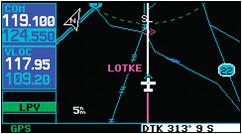I recently had the “pleasure” to complete my yearly recurrent ride. As it happens, our fleet of PC12NGs is getting a software update, which will eventually allow us to complete LPVs approaches virtually everywhere. Although we (the company) have been able and trained to conduct LNAV approaches where applicable, the introduction of VNAV/LPV technology brings up a completely new dimension (yup, 3D approaches!) So training for the use of the GPS for approaches and a quick review of the related rules was incorporated in the ride.
Before we go any further, I would strongly suggest that you read the first part of this article (if you have not done so already) to familiarize yourself with a few terms and basic underlying principles.
The tolerance tresholds and levels of performance required vary greatly for the use of a GPS module depending on the phase of flight. GNSS may be used for all en-route and terminal operations, as long as the aircraft is also equiped with approved traditional systems (such as VOR and ADF) to serve as backup. Avionics also have to meet the appropriate equipment standards and be approved by the governing flight authority (FAA, Transport Canada, etc..)
Let’s have a look at the different requirements for each phase of flight.
(Source: Transport Canada AIM)
| Phase of Flight | Receiver Capability |
| En-Route | GPS or WAAS |
| Terminal | GPS or WAAS |
| Non-Precision Approach (LNAV) | GPS or WAAS |
| LNAV/VNAV | WAAS (Lateral and Vertical) |
| LNAV/VNAV | GPS/WAAS Lateral; BARO-VNAV Vertical |
| LPV | WAAS (Lateral and Vertical) |
In simple terms, here are the three main things a pilot needs to know when planning on flying a GPS-based approach:
Types of Approaches available (and their requirements)
In the days of old, only two types of approaches existed: Precision Approaches (PA) and Non-Precision Approaches (NPA). With the arrival of the new cool kid on the block (GNSS), a new definition has been added to cover approach and landing operations with vertical guidance (APV) which use lateral and vertical guidance, but do not meet the PA requirements.
There are two types of GNSS-based approaches:
- GPS Overlay
- RNAV.
The RNAV is in turn divided in three sub-categories:
- LNAV (lateral navigation only – NPA)
- LNAV/VNAV (lateral/vertical navigation – APV)
- LPV (localizer performance with vertical guidance – APV)
NOTE: When you are planning to execute an RNAV or Overlay approach, always ensure that your GPS IFR database is up to date. All approach waypoints MUST be retreived from the database. Pilot-made waypoints are only acceptable en-route.
Vertical Guidance – Benefits and Constraints
Approaches with vertical navigation or guidance offer many safety benefits, including a more stabilized approach and higher success rates. However, they also bring in a completely new dimension that pilot must understand fully. This is where it becomes extremely important for you to know exactly what equipment is available to you and what it allows you to do when used for approach purposes.
There are two main modes of vertical guidance: BARO VNAV or WAAS-augmentation (Class 2/3). Some aircrafts use multi-sensor FMS+, but were rarely found in General Aviation until the recent marketing of glass cockpits.
RNAV and Overlay Approaches with Lateral Guidance Only
A LNAV approach can be considered as a regular Non-Precision Approach. It does not provide or define any vertical path but instead must be flown using the step-down altitudes using a regular barometric altimeter. They can be flown using any IFR-certified GPS or WAAS-augmented GPS. WAAS may provide vertical guidance during the approach but it is important to recognize that this guidance is ADVISORY only.
In one case, an approach labeled such as (GNSS) VOR RWY XX – otherwise known as a GPS Overlay Approach – a traditional VOR or NDB-based approach which has been approved to be flown using the guidance of an IFR-certified GPS (LOC and LOC/BC are not approved for overlays). This kind of approach is extremely useful, as it allows a pilot to conduct a straight-in approach via the FAF (while respecting minimum sector altitudes). An overlay approach can be conducted without the need to monitor the underlying nav-aid, and is also permissible when the underlying nav-aid is temporarily out of service.
An approach labled RNAV (GNSS) RWY XX – GNSS-based RNAV approach – is another type of NPA LNAV approach. It consists of a series of waypoints in a “T” or “Y” pattern (generally), thus eliminating the need for a procedure turn.
Missed Approach Waypoint definition: MAWP (Missed Approach Way Point), usually located over runway threshold.
RAIM: Pilots using GPS with no WAAS augmentation should (not shall) use the RAIM prediction to ensure approach level RAIM availability at destination or alternate for the ETA (+/-15mn) before takeoff and prior to commencing approach.
RNAV Approaches Lateral and Vertical Guidance
If you are equipped with WAAS 2/3 or Multi-sensor FMS, you may fly RNAV (GPS/GNSS) to the depicted LNAV/VNAV minimums using vertical guidance in a similar way to an ILS, using both your CDI and VDI (vertical deviation indicator). The vertical guidance must be based on WAAS (2/3) or barometrics inputs (BARO VNAV) depending on the approach and aircraft equipment.
BARO VNAV (TSO C115)- derivates vertical guidance from a barometric altitude input. The information provided by these systems is ADVISORY ONLY, making it mandatory for the pilots to respect all minimum step-down altitudes. It must be noted that the Vertical Flight Path indicated by the BARO VNAV is affected by altimeter setting errors (wrong setting, cold temperatures). BARO VNAV is thus not authorized unless a local and current altimeter setting is obtained.
LPV (TSO C145/6) – If you are equipped with WAAS Class 3, RNAV (GNSS) approaches can be flown to LPV minima just as an ILS would. WAAS provides both lateral and vertical guidance in this case and meets essentially the same navigation performance requirements (accuracy, integrity and continuity) as ILS, with even some signal stability improvements. When flying an LPV, pilots should verify the final approach waypoint (FAWP) crossing altitude in the same manner as the beacon crossing altitude check on an ILS.
Missed Approach Waypoint definition:
– LNAV/VNAV missed approach can be either defined by a Decision Altitude or a MAWP (as with a regular LNAV).
– LPV missed approach is defined by a DA, (minimum 250′ HAT).
Use of GNSS at IFR Alternate Airport
Note: This section has been pulled directly from the Transport Canada AIM
Risk assessment of GNSS performance has made it possible to relax the restriction that prohibited taking credit for GNSS-based approaches when selecting alternate aerodromes for flight planning purposes. This includes aerodromes served only by GPS-based approaches.
Pilots can take credit for a GNSS-based approach at an alternate aerodrome when all of the following conditions are met:
(a) A usable approach at the planned destination is served by a functioning traditional aid. This is to ensure that an approach is available in the event of a widespread GPS outage. (Good airmanship dictates that the weather forecast at the destination should provide confidence that the approach could be used successfully.) This approach must be completely independent of GNSS. Note that this precludes the GNSS in lieu of ground-based aids credit;
(b) The published LNAV minima are the lowest landing limits for which credit may be taken when determining alternate weather minima requirements. No credit may be taken for LNAV/VNAV or LPV minima;
(c) The pilot-in-command verifies that the integrity, provided by RAIM or WASS, and that is required for an LNAV approach, is expected to be available at the planned alternate aerodrome at the ETA, taking into account predicted satellite outages; and
(d) For GPS TSO C129/C129a avionics, periodically during the flight, and at least once before the mid-point of the flight to the destination, the pilot-in-command verifies that approach-level RAIM is expected to be available at the planned alternate aerodrome at the ETA. This may be accomplished using the RAIM prediction capability of the avionics. If an in-flight prediction indicates that approach-level RAIM will not be available at the alternate, the pilot should plan accordingly. (In-flight predictions are not required for TSO C145a/C146a avionics.)
For the purposes of determining alternate weather minima per TC AIM RAC 3.14.1 or the CAP GEN section, LNAV/VNAV shall be considered to be a non-precision approach.
NOTE: These provisions are applicable to meet the legal flight planning requirements for alternate airports. Once airborne, pilots are free to re-plan as needed to accommodate changing situations while exercising good airmanship.
Taking credit for RNAV (GPS) and RNAV (GNSS) approaches at an alternate aerodrome for IFR flight plan filing purposes is possible because the availability of RAIM or WAAS integrity to support non-precision approaches is normally very high. However, when satellites are out of service, availability could decrease. Consequently, it is necessary to determine satellite status to ensure that the necessary level of integrity will be available at the ETA at the alternate, as indicated by 3.16.12(c), above. The procedures for this are explained in the next
two sections.
3.16.12.1 GNSS Approaches at Alternate Aerodromes – GPS (TSO C129/C129a) Avionics
The status of the GPS constellation may be obtained through the FAA by contacting a NAV CANADA flight information centre (FIC) and requesting the international NOTAM file KNMH.
A procedure that meets the requirement to ensure that approach-level RAIM will be available at the alternate for TSO C129/C129a avionics is:
(a) Determine the ETA at the proposed alternate aerodrome following a missed approach at the destination.
(b) Check GPS NOTAM (KNMH) file for a period of 60 min before and after the ETA. If not more than one satellite outage is predicted during that period, then 3.16.12(c) is satisfied. If two or more satellites are anticipated to be unserviceable during the ETA ±60-min period, then it is necessary to determine if approach-level RAIM will be available, taking into account the reduced availability resulting from the outages. This may be accomplished by using commercially-available dispatch RAIM prediction software, acquiring a current almanac, and manually deselecting those satellites for the times described in the NOTAM.
The RAIM availability requirement is satisfied if the resulting prediction indicates that RAIM will be unavailable for a total of 15 min or less during the ETA ±60-min period.
It may be possible to change the alternate or adjust the departure time (and hence the ETA at the alternate) and re-run the prediction to find a time for which the required RAIM availability is achieved, or simply to find a time when fewer than two satellite outages are predicted.
3.16.12.2 GNSS Approaches at Alternate Aerodromes – WAAS Avionics
Verifying that an LNAV approach is expected to be available is less complicated for operators using WAAS avionics (TSO C145a/C146a). Simply check the national (CYHQ) and FIR NOTAM files to ensure that the WAAS NOTAM system has not failed, and that no widespread WAAS outages have occurred, and then check the aerodrome NOTAM file for the alternate to ensure that LNAV will be available.
The NOTAM system automatically evaluates if sufficient integrity will be available from WAAS GEO satellite messages. In the event of a widespread outage of WAAS messages (as in the rare case of a GEO satellite or total system failure), or at an aerodrome outside the GEO coverage area, it determines if approach-level RAIM, as computed by a WAAS receiver, will be available. For all of these situations, the absence of an aerodrome NOTAM will give the pilot a reasonable assurance that an LNAV approach will be available.
If the WAAS NOTAM system has failed, a national NOTAM will be issued, indicating that WAAS is unmonitored. In this case, the pilot may use the procedure described in the preceding section for TSO C129/C129a avionics. This will provide a safe, although conservative indication of the availability of LNAV.
What is in store for the Future?
There has been a lot of controversial issues related to the use of GNSS. System backup is one of the main concerns, especially because for the time being only the American GNSS is being used as the only satellite feed for the receivers.
Interference (intentional and unintentional)and Anomalies are also a major concern, as GNSS satellite signals are relatively weak. Intentional interference remains a key safety concern to address by the international, as next-generation satellites will broadcast on multiple frequencies make the probability of unintentional interference negligible. agencies.
Finally, decisions will have to be made on a case-by-case basis for the complete removal of traditional navigation aids for en-route and approach operations.
*************
Quick Reference
TSO C129 vs C145/6 – How to Tell?
TSO C129
TSO C145
TSO C146
*************
If you have any questions or comments, please feel free to leave one here and I will reply as soon as possible!







[…] You can find PART 2 of this article Here. […]
[…] You can find PART 2 of this article Here. […]
Hi I really appreciate your positing.
I’m studend in Korea so please forgive my bad english
I leave a reply to ask something.
I understand that LNAV/VNAV and LPV are non-precision approach but using DA(H)
like precision approach.
Can I find some official(ICAO or FAA..) definition or explain about
“GPS approach(whether itis APV or not)is non-precision approach”
and the reason of using DA while it is non-precision approach?
Thank you!
Hi I really appreciate your positing.
I’m studend in Korea so please forgive my bad english
I leave a reply to ask something.
I understand that LNAV/VNAV and LPV are non-precision approach but using DA(H)
like precision approach.
Can I find some official(ICAO or FAA..) definition or explain about
“GPS approach(whether itis APV or not)is non-precision approach”
and the reason of using DA while it is non-precision approach?
Thank you!
Hi HSK!
The Transport Canada AIM (Aeronautical Information Manual) describes LNAV/VNAV and LPV approaches as using DA (Decision Altitudes) despite being non-precision approaches, you are right.
RNAV approaches on the other hand (no VNAV guidance, or overlay approaches) however dictate the use of an MDA rather than DA.
Here is the quote out of the Transport Canada AIM, COM 3.16.5.2.3 Vertical Guidance on RNAV Approaches:
LNAV/VNAV and LPV describe approaches with vertical guidance. These will deliver the safety benefits of a stabilized approach and, in many cases, will improve airport accessibility. However, as with any advance in aviation, pilots must appreciate the relevant requirements and limitations.
Aircraft with TSO C145a/C146a (WAAS Class 2 or 3) or TSO C115b (multi-sensor FMS) avionics, may fly RNAV (GPS) and RNAV (GNSS) approaches to LNAV/VNAV minima with vertical guidance in a similar manner to the way they fly an ILS approach: with both a lateral course deviation indicator (CDI) and a vertical deviation indicator (VDI). The lateral guidance must be based on GPS or WAAS. The vertical guidance may be based on WAAS, or on barometric inputs (BARO VNAV), depending on the approach and the aircraft equipage.
Aircraft with WAAS Class 3 avionics may fly RNAV (GNSS) approaches to LPV minima in a similar manner. In this case, both the lateral and vertical guidance are based on WAAS.
The nominal final approach course vertical flight path angle for LNAV/VNAV and LPV approaches is 3°, avoiding the step-down minimum altitudes associated with traditional non-precision approaches.
The LNAV/VNAV and LPV minima depict a decision altitude (DA), which requires the pilot to initiate a missed approach at the DA if the visual reference to continue the approach has not been established. In most cases, the DA associated with LNAV/VNAV or LPV approaches will be lower than the LNAV MDA, since the LNAV/VNAV and LPV approach designs use a sloped vertical obstacle clearance surface.
Thank you very much!!
And I love this blog 🙂
Thank you so much for your kind words and honoring me with your interest. I hope that you can pass the word around and share this with your friends!
Safe flying.
[…] You can find PART 2 of this article Here. […]